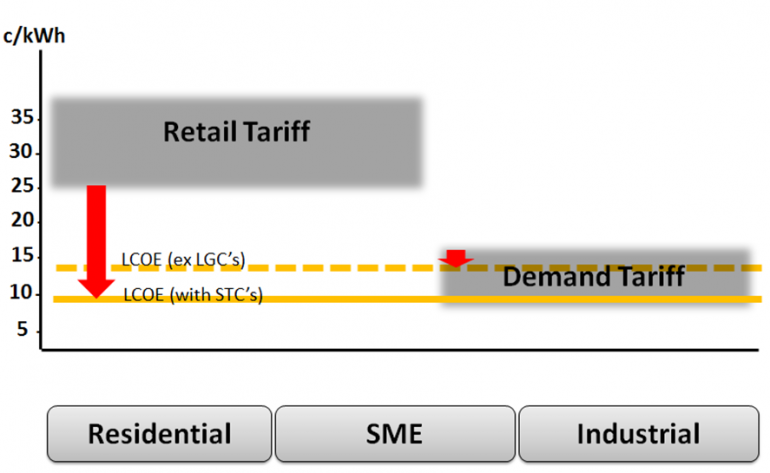Have renewables slayed the fossilised monster?
In yesterday’s article I posed the question if renewables are soon to be, or are already competitive, with conventional fossil fuels then why in the hell do they need a government leg-up?
In reality, I think that when you delve deeper into claims about cost-competitiveness of renewables, you often get some greater context that helps to illustrate that it’s a bit more complicated than the initial headline claim.
If we take, for example, my chat with Tom Werner of Sunpower. He points out that they’re now in the process of building a solar power project in Chile without any form of government support, not even a carbon price. This leads some people to get a bit carried away into believing that solar is therefore cost-competitive with fossil fuels, full stop.
But Werner also notes that the project involves a coincident set of ideal circumstances that allow this to happen: very high levels of solar radiation, availability of cheap flat land, and a high underlying cost to supply power with conventional fossil fuels in that location.
During the interview (see transcript to second part here) when he told me that they can build ‘ground-mount’ solar projects competitive at $US100 per MWh, and this was possible in Australia, I had mistakenly interpreted him to mean that this applied to projects likely to be built in off-grid mine sites (which are ‘ground mount’). In reality he was talking about projects of a scale way beyond what you’d build at off-grid sites, which is typically below the 10 megawatt mark. The project from which he drew the $US100/MWh figure, the California Valley Solar Ranch, is 250MW, which would only be accommodated in major Australian electricity grids.
Such confusion about the precise circumstances surrounding a cost claim is not uncommon (it's rife in nuclear power) and can lead to a misleading impression of where renewables sit relative to conventional competitors.
This also helps to explain a discrepancy one clever reader highlighted in the comments section of yesterday's article, which is that the ACT large-scale solar auction achieved prices far higher than $110/MWh or $US100 per MWh (winning bids were between $178/MWh and $186/MWh). The winning ACT projects were 20 MW or less, which is an awful lot smaller than California Valley Solar Ranch.
In addition, Sunpower’s Chris O’Brien explained that in order to achieve $US100 per MWh you’d need projects built at locations with a solar resource equal or better than Broken Hill. This is a fair bit better than what’s available in the ACT. Furthermore, the area of Australia that has such a solar resource tends to fringe the main grids of Australia rather than lie smack bang in most of the main transmission corridors. This also acts to somewhat constrain the amount of capacity that could feasibly achieve such low costs, at least right now.
In relation to wind power, the Snowtown II wind project also grabbed many people’s attention with its low capital cost and very high output. But one renewables enthusiast, using what must be a very simplistic set of financials, made the amazing claim it was producing power at a cost of $43 per MWh. Yet a review of the company's own supplied financials suggested $80 was more likely once you adopted realistic financing costs. In addition, when you talk to those involved in Snowtown you get the impression there aren’t too many other sites in Australia that can match its exceptional wind resource, while being reasonably close to spare transmission line capacity.
Then there’s the area of solar’s competitiveness in the rooftop space. Based on the current structure for pricing electricity to residential and small business consumers which are based on kilowatt-hours consumed, not peak demand, solar PV is competitive.
But both power companies and regulators want to change towards tariff structures where smaller customers pay a lot less per kilowatt-hour consumed, with much of their electricity bill composed of a fixed charge or a peak demand charge. This is how larger commercial and industrial customers are charged.
The chart below prepared by Patrick Greene from the solar company Ingenero illustrates how for small retail customers paying prices in the range of 25 to 35 cents per kilowatt-hour, the cost of energy from solar including the RET scheme discount (‘STCs’) is vastly lower. His estimate in the solid yellow line is 10 cents per kilowatt-hour. But for industrial customers on what is known as a Demand Tariff, solar is not nearly as attractive. For many people even though solar might be equivalent per kilowatt-hour, they can’t be bothered with the hassle and the upfront cost of the system.
Solar power cost competitiveness under different customer tariff structures

Source: Patrick Greene, Ingenero – presentation given at Doubling Energy Productivity Forum, April 2014
So while solar PV may look like it could compete very well now without support from the RET in the residential space, this could completely change in the future based on where regulators and utilities are potentially heading.
I should also mention that while gas prices have been soaring in Australia, if demand for gas globally were to drop (say because of wind and solar becoming cheaper) then so will price. Also, the recent gas deal between Russia and China will up pricing pressure on Australian LNG. In the short term it probably won’t do much to relieve price inflation but it might make a difference in the future. In the 1970s a belief took hold that fossil fuels would continue to escalate in price – but then in the 1980s they plummeted. Fossil fuel pricing is not necessarily a one-way street.
So before declaring victory, renewable energy enthusiasts should be very careful.
















